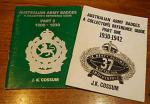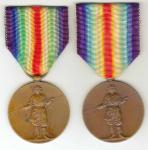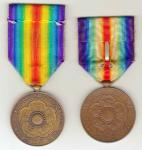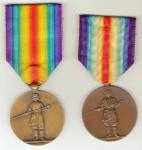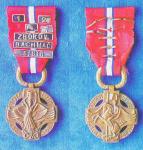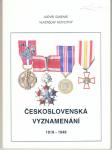-
Posts
1,169 -
Joined
-
Last visited
-
Days Won
1
Content Type
Profiles
Forums
Blogs
Gallery
Events
Store
Everything posted by RobW
-
To all, As fate would have it I have just relocated copies of some of my Australian badge books by J.K. Cossum that had been previously not been seen for a while. As an aide to others I thought it would be advantageous to post images here of all the J.K. Cossum reference books I'm aware of. I am not sure of how available all these books will be to those outside of Australia but it is far better to know these references exist than not. Not wishing to infringe on anyone's copyright I will only post pictures of the covers for the general reference and awareness of all. I will start with the series of three books on Australian Army badges, that were discussed earlier in this post, and will follow with others that have been published later. The format will be cover image, relevant ISBN, and any publishing details. I hope they are of use. More to follow. Regards, Rob
-
To all, Here is another nice miniature version of one of the other Fascist medals from the period. It is the Commemorative Medal for march on Rome, type 'E' by Johnson (according to the Brambilla reference). The ribbon is a lovely colour; not quite yellow but more of a mustard colour. Hope they are of use. Regards, Rob
-
To all, To add to the store of pictures here is a nice miniature version of the Commemorative Medal for the Fascist Campaign 'Italy Now and Always' in bronze. As has been previously stated the medal did come with a number of different dated year bars. This mini has 3 but they are not dated presumably indicating 3 years service sometime between 1919-1922. More to follow. Regards, Rob
-

WW1 Victory Medals General Discussion
RobW replied to JimZ's topic in Inter-Allied Victory Medals of the Great War
Followed by part two. The U.S. medal variety is listed without any battle (engagement) orservice (country) clasps which would necessitate a separate display initself. Regards, Rob -

WW1 Victory Medals General Discussion
RobW replied to JimZ's topic in Inter-Allied Victory Medals of the Great War
To all, As requested by Jim Z and to assist others, here are some panoramic comparison pictures of the archetypal specimens from each of relevant countries in the victory medal series from my collection. While there are other strikes and many different unofficial and reproduction varieties, those that are displayed here are what are deemed 'official' strikes. While I have a much higher resolution version of the combined panoramic comparison I am unable to post it due to new member restrictions. I have posted these smaller matching items to negate the need for too much side scrolling. I hope it is of use to others. Here's part one. Regards, Rob -
-
To all, Here is a recent group I obtained, with a nice Belgian vic mini, among others. The Belgian vic mini is 13.5 mm in diameter. I was interested in the level of detail on the orders, and in particular the enamel work. Due to the limited number of participants the campaign medal for the African Campaign is not often seen. L-R, Officer of the Order of the Crown, Officer of the Royal Order of the Lion, with palm, War Cross, with palm, Commemorative Medal of the African Campaign, Volunteer Combatants Medal, Belgian Victory Medal, and War Commemorative Medal. Regards, Rob
-
Hello Mervyn, I would agree that outside of Australia they are difficult items to find. ISBN for volume 1 : ISBN 0949530018 ISBN for volume 2 : ISBN 0949530026 ISBN for volume 3 : ISBN 0949530050 I had all 3 volumes back in the early 1990s but have since managed to either lend them to another collector or mislaid them. A dealer friend in Sydney has all 3 volumes and has indicated, that while Mr Cossum does not intend to provide an update to the books, another publishing house and author is apparently going to attempt an update. When I have more information I will post here. I have found copies in the past at some well known used bookstores on the web. I always use <abebooks.com> and <used.addall.com>. I think you might find them there. A small picture from an unnamed auction house will show some detail of the book covers for vol's 1 & 2 for your reference. Hope this helps. Regards, Rob
-
To all, If you are at all interested in Australian hat badges, as well as general issue unit badges, I would recommend that you try and locate copies of 3 very good books by the Australian author J.K. Cossum. Aside from being marvelously illustrated in black and white, these books are considered the main references for all things Australian hat badges and more. The titles are: a. Australian Army Badges, A Collectors Reference Guide, Part 1, 1930-1942, 35 pp b. Australian Army Badges, A Collectors Reference Guide, Part 2, 1900-1930, 56 pp, and c. Australian Army Badges, A Collectors Reference Guide, Part 3, 1948-1985, 64 pp. I hope this helps. Regards, Rob
-
Hugh, As far as I have been able to determine, in regards an order of precedence, until 1939 Czechoslovakia only had only 4 official (government approved) decorations. These were: a. The Order of the Falcon, which was established in 5 clases but only one was awarded. b. War Cross 1918 c. Revolution Medal d. Victory Medal All other medals listed in the book were described as so called semi-official, established either by regiments, veteran organizations or others, which were additionally approved for wearing the by Defence Ministry. This of course didn't include the following: a. Volunteer's Cross (Pamětní Kříž Československého Dobrovolce), 1918-1919 b. Commemorative Decoration for the Czechoslovak Volunters of 1918-1919 I would assume that these awards would be worn after the main 1914-1918 awards and before those awarded for service later in 1939 onwards. In addition to these original 4 pieces there was also the Order of the White Lion (instituted in 1922). The Order of White Lion was created in two divisions (civil and military) 5 classes and 2 medals each. It was however awarded strictly to foreigners only. The only Czech bearer was the President of the Republic as a Grand Master of the order. This information has been gratefully provided to me via a Czech friend in Prague and subsequently translated/parsed into English. I hope that this helps. Regards, Rob
-
To Hugh and Rick Research, Here are a few clarifications and additions to the earlier information about the Czech Revolution Medal. As everybody serving in Czech legions was eligible, many variants were produced. The medal was designed by the French sculptor Antoine Bourdel, and it is his initials 'AB' which can be found on some varieties. The Czech medal book referred to previously lists 4 main varieties. These are: a. French production with signature b. Production 1918 - 38 light bronze with signature c. Dark bronze with signature d. The same as 'b' but without a signature There are also more varieties indicated but unlisted with hollow pieces being described as quite common, so that should clear up the mystery of Ricks piece. I recently picked up a second copy of the 1997 book as well. Order of precedence information to follow shortly. Regards, Rob
-
To all, Just to confuse the issue I recently obtained this official French vic and it does appear to not have any marks, either cornucopia, triangle, or BR on the reverse. Is it possible that another manufacturer produced this based on the official dies? The only other difference I have noticed is that the makers mark is a bit further from the edge of the rim than that seen on other varieties. Any ideas?? Regards, Rob
-
-
Dieter3, Here are 2 of my japanese vics for a side-by-side comparison. Note the differences in ribbon hues between the two, and the strength of the green band on the medal on the left. Hope this helps. Regards, Rob
-
Hello Dieter3, The ribbon that is used on the Japanese vic is generally chacterised by having quite a paler appearance than the ribbon used by other countries for their vics. Of note is that the yellow and green bands are generally quiet pale and almost absent, although I have a specimen in my collection that has a definitive green band. All original Japanese vics will have the standard 'hook and eye' on the ribbon reverse, for mounting, as well. The French ribbon again has a number of different variations depending on when it was produced but the colours are generally consistent, pretty vivid and strong. I shall post a side-by-side comparison of two Japanese vics with slightly different ribbon hues when I have time shortly. Regards, Rob
-
Hugh, There are two such lists in the book that could possibly be an order of precedence but not being able to read Czech I can't tell for sure. Not wishing to post ill-informed comment I am making some inquiries with those more competent than I in the Czech language and medals and when I have a definitive list I shall post here. Regards, Rob
-
Hugh, Happy to be of help! I have not seen such a type either in my collection (4 pieces) or through my hands. All the pieces I've had or seen, have been one piece struck medals with very good detail and certainly not two piece and joined together, and they were of the early type (marked AB) as well as the later issues so I'm at a loss there. In addition, I've inquired with a number of other collectors in Sydney who have not seen such a hollow two piece type. Just because it hasn't been seen doesn't mean it isn't possible. I have sent a query to a collector friend in Prague and shall post the results when known. Regards, Rob
-
And the reverses. Note the differences in detail of the flags and the slight differences and weight of the japanese inscriptions around the edge. In addition there are a number of instances where different characters are used, in particular at the bottom centre 6 o'clock position on the rim inscription. Hope these pics help comparisons. Regards, Rob
-
To all, For a direct L-R side by side comparison here are a French made repro and a Japanese vic official. The first of the French made repro's were produced in the mid to late 1920's and were not all edge marked. Some have been seen with just BRONZE on the edge with others unmarked. Those produced in the 1930's have the edge marking 'MADE IN FRANCE' to comply with the US Tariff Law of 1931, which required marking with the country of origin. There is, in addition, to the standard repro, a cast copy of the French repro as well. It has an even shallower field of detail, is suspended by a ball suspender and has the same French made ribbon. When I can find it I shall post pics. Regards, Rob
-
-
-
-
Hello Hugh, In answer to your question, and to echo the reply of 'Rick Research' the number on the ribbon of the Czech Revolutionary Cross/Medal is the number of the regiment and/or Czech Legion the participant served in. There were a number of different numbered devices depending on where the recipient served. The shields with numbers relate to the following regiments-legions and locations: a. Russian Legion - 1-12 b. French Legion - 21-24 c. Italian Legion - 31-35 and 39 In additional to the regimental numbers there were a number of named shields and bars that indicated action participation as follows: a. ČD (Česk? dru?ina or Czech Brigade) b. L.E. (L?gion ?trang?re or Foreign Legion). c. Russian Legion - ZBOROV, BACHMAČ, SIBIŘ. d. French Legion - ALSACE, ARGONNE, PERONNE. e. Italian Legion - DOSS' ALTO, PIAVE. d. Those in Serbia - S or SERBIE. There are numerous reproductions of these bars with original ones considered quite rare. What complicates matters is that some original manufacturers have also produced recent versions as well so it is quite difficult to differentiate repro from original. There were also four different versions produced as follows: a. Type 1 ? Bronze cross 1918-19, stamped AB (as in your example). b. Type 2 ? Light bronze 1920-38, c. Type 3 ? Dark bronze 1920-38. d. Type 4 - Bronze 1920-38 without stamping. In regards the Order of the White Lion, Commander's Cross for Civil (3rd Class) ? 1st Type, Neck badge, the makers mark 'KK' belongs to the Prague firm of Karnet and Kysely. It was the biggest Czech medal producer before 1948, and produced all manner of Czech orders and decorations, including a re-issue of the Czech Victory medal. Pictures to follow. I hope that this helps. Regards, Rob
-
To Rick Research, Could I assume that the handy Czech reference book (in the Czech language) is either: "Československ? Vyznamen?n?, 1918-1938, Vol 1, Měřička Vacl?v, 1973" or "Československ? Vyznamen?n?, 1918-1948, Vol 1, Ludv?k Suken?k & Vlastislav Novotn?, 1997" I have a copy of the 1997 edition, as shown, and it is a truly wonderful reference book. Further details re the Czech Revolutionary Cross/Medal to follow. Regards, Rob








